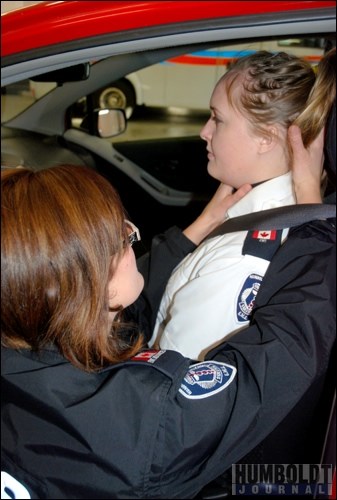It's a dark and stormy night in December. You're driving along the highway, snow is blowing, and it's hard to see. The vehicle in front of you goes off the road. It flips and rolls and lands in the ditch.
Heart racing, adrenaline rushing, hands shaking, you try to process what has happened. And two questions arise: Do you stop to help or keep going? And if you stop to help, what do you do?
These are things that people should ask themselves before they are ever in this situation, notes Mandy Herman, an Intermediate Care Paramedic (ICP) with Humboldt and District Ambulance Service.
As a way to educate the public about what to do in this and other emergency medical situations people may find themselves in, staff of Humboldt and District Ambulance Service have agreed to share their expertise with the Journal and its readers on a regular basis.
Because it's winter in Saskatchewan, and many are out on the roads in December, it was felt that what to do when coming across a motor vehicle collision would be timely advice to give.
"The first thing you need to think of is your own personal safety," Herman advised. "Take a look around to see if there is any fuel leaking, sparks, fire or fallen down power lines. Also be sure to park with your hazards on and in a position that you are alerting other drivers but not putting yourself in a dangerous position. And, of course, call 911."
If all seems safe, you should get out of your car and approach those in distress.
"Talk to them and tell them help is on the way," Herman said. "Keep them warm with blankets in cold weather and provide any basic first aid you think they may need."
But do not move them. And try to keep them from moving around themselves.
That is a very, very important point.
"It is very important that those who are injured stay still and do not move any more than they may already have," Herman stressed.
This is in case the person has suffered a fracture in their spine.
If someone with a spinal fracture moves around or is moved, there is a chance that the broken bone could cut or damage the spinal cord.
"This would lead to death or paralysis to the whole body or part of the body,depending where the damage is done," Herman said.
Not moving will help an injured person avoid further injuring themselves or making any possible spinal injury worse.
"You may even ask or remind them to keep looking straight ahead and not to move their head side to side," she said.
The same basic principles apply in this situation as for any sort of medical emergency you may come in contact with, Herman indicated: protect yourself, call emergency services and provide basic first aid or comfort care to the patient.
"Even if you don't feel like there is much you can do, a call to 911 is help enough," Herman stated.




